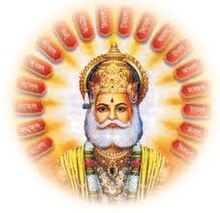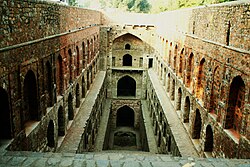
Lakshmi also known as Shri, is one of the principal goddesses in Hinduism. She is the goddess of wealth, fortune, power, beauty, fertility and prosperity, and associated with Maya ("Illusion"). Along with Parvati and Saraswati, she forms the Tridevi of Hindu goddesses.
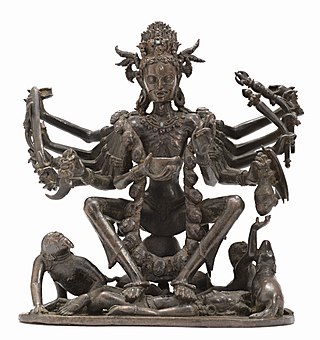
Chamunda, also known as Chamundeshwari, Chamundi or Charchika, is a fearsome form of Chandi, the Hindu mother goddess, aka Shakti and is one of the seven Matrikas.

Vishvamitra is one of the most venerated rishis or sages of ancient India. Vishvamitra is one of the seven Brahmarshi. According to Hindu tradition, he is stated to have written most of the Mandala 3 of the Rigveda, including the Gayatri Mantra (3.62.10). The Puranas mention that only 24 rishis since antiquity have understood the whole meaning of —and thus wielded the whole power of — the Gayatri Mantra. Vishvamitra is supposed to have been the first, and Yajnavalkya the last.
Hindi literature includes literature in the various Hindi languages which have different writing systems. Earliest forms of Hindi literature are attested in poetry of Apabhraṃśa like Awadhi, and Marwari languages. Hindi literature is composed in three broad styles- गद्य (Gadya-prose), पद्य( Padya- poetry) and चम्प्पू In terms of historical development, it is broadly classified into five prominent forms (genres) based on the date of production. They are:
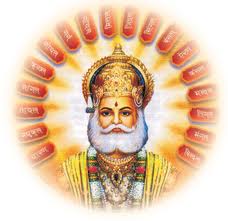
Agrawal is a Hindu Bania community. The Banias of northern India are really a cluster of several communities, of which the Agarwal Banias, Maheshwari Banias, Oswal Banias, and Porwal Banias are mentioned separately in connection with certain They are found throughout northern and central India, mainly in the states of Rajasthan, Haryana, Punjab, Jammu and kashmir, Chandigarh, Himachal Pradesh, Uttarakhand, Delhi, Chhattisgarh, Gujarat, Maharashtra and Uttar Pradesh. They are also found in Pakistani provinces of Punjab and Sindh, though at the time of the partition of India, most of them migrated across the newly created border to independent India. The majority religions followed by the Agrawals include Vaishnava Hinduism and Jainism.
Agroha is a town in Haryana state of northern India. It is situated in Hisar district in between Hisar city and Fatehabad on NH 09. Ancient structures, pot-shards, coins and seals have been found in archaeological excavations at the Agroha Mound. The Agrawal and Agrahari communities claim origin from Agroha. According to their legends, Agroha was the capital of their founder Maharaj Agrasena.

Vallabha, Vallabha Acharya or Vallabhācārya was an Indian saint and philosopher. He founded the Krishna-centered Pushtimarg sect of Vaishnavism in the Braj (Vraja) region of India, and propounded the philosophy of Shuddhadvaita.

The Puṣṭimārga or Pushtimarg, also known as Vallabha Sampradāya, is a sect of Vaishnavism. It was founded in the early 16th century by Vallabha (1479–1531) and was later expanded by his descendants, particularly Viṭṭhalanātha. Pushtimarg adherents worship Kr̥ṣṇa, and tradition follows universal-love-themed devotional practices of youthful Krishna which are found in the Bhagavata Purana and those related to pastimes of Govardhana Hill.
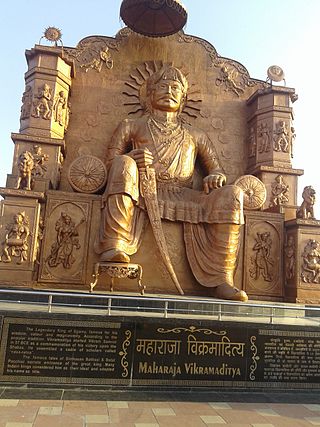
Vikramaditya was a legendary king mentioned in ancient Indian literature, featuring in traditional stories including those in Vetala Panchavimshati and Singhasan Battisi. Many describe him as ruler with his capital at Ujjain. "Vikramaditya" was also a common title adopted by several monarchs in ancient and medieval India, and the Vikramaditya legends may be embellished accounts of different kings. According to popular tradition, Vikramaditya began the Vikrama Samvat era in 57 BCE after defeating the Shakas, and those who believe that he is based on a historical figure place him around the first century BCE. However, this era is identified as "Vikrama Samvat" after the ninth century CE.
Meham, also spelled Maham, is a small city in Rohtak district of the Indian state of Haryana. It is one of the two sub-divisions in Rohtak district. As a tehsil, it is further divided into two community development blocks, Maham and Lakhan-Majra.

The Sachchiya Mata Temple is a Hindu temple located in Osian, near Jodhpur city in the Indian state of Rajasthan.
Maharaja Ahibaran was a legendary Indian king (Maharaja) of Baran, a city of traders. Maharaja Ahibaran was born on 26 December.

Agrawal Jains are an Indian Jain community who originated from Agroha near Hisar, Haryana. In Sanskrit inscriptions and texts, the community is termed Agrotakanvaya.
Agroha is a Hindu temple complex in Agroha of Hisar District, Haryana, India. Construction started in 1976 and was completed in 1984. The temple is dedicated to the Hindu goddess Mahalakshmi.
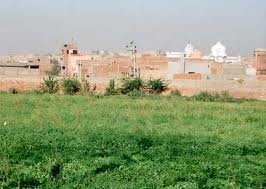
Agroha, locally known as Ther, is an archaeological site located in Agroha, in the Hisar district of India.
Kuchchal or Kuchhal is an Indian clan of the Agrawal community. Agrasen established 18 Gotras (clans) for each of his 18 Ganadhipati based on the names of their Guru and divided his empire among them.

The Maharaja Agrasen Medical College, Agroha (MAMC) is a medical college in Agroha affiliated to Pt. B.D. Sharma University of Health Sciences, Rohtak and recognized by Medical Council of India. It is named after a legendary Indian king of Agroha Maharaj Agrasen. It is located at Agroha, Haryana, India. The college was founded by Om Prakash Jindal while his wife Savitri Jindal is the current president of the society that governs the institute.
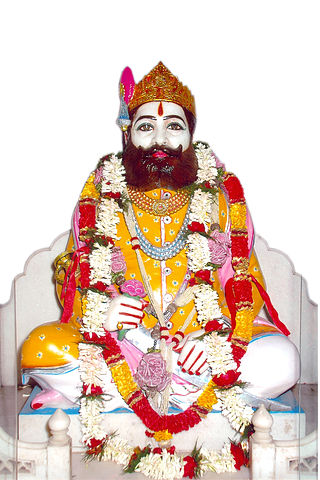
Agrasen Jayanti is the birth anniversary celebration of a legendary Hindu king Agrasen Maharaj. He was king of Agroha, and it was from him that the Agrawal caste originated. Agrasen Jayanti is observed on the fourth day of Ashwin month of Hindu calendar.
The Nagvanshis of Chotanagpur, also known as the Khokhra chieftaincy, was an Indian dynasty which ruled the parts of Chota Nagpur plateau region during much of ancient, medieval and modern period. Phani Mukut Rai is considered the first king of dynasty claim to be son of Pundrika Naga, a mythical Naga. Lal Chintamani Sharan Nath Shahdeo (1931–2014) was last ruling king of the dynasty, until the estate was merged to the Republic of India.
